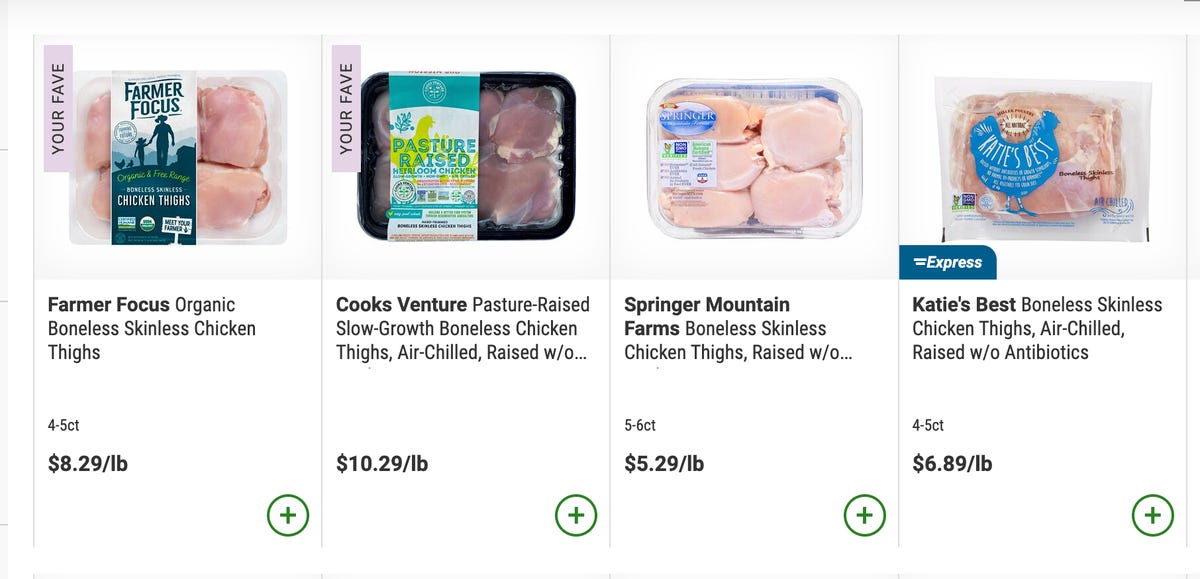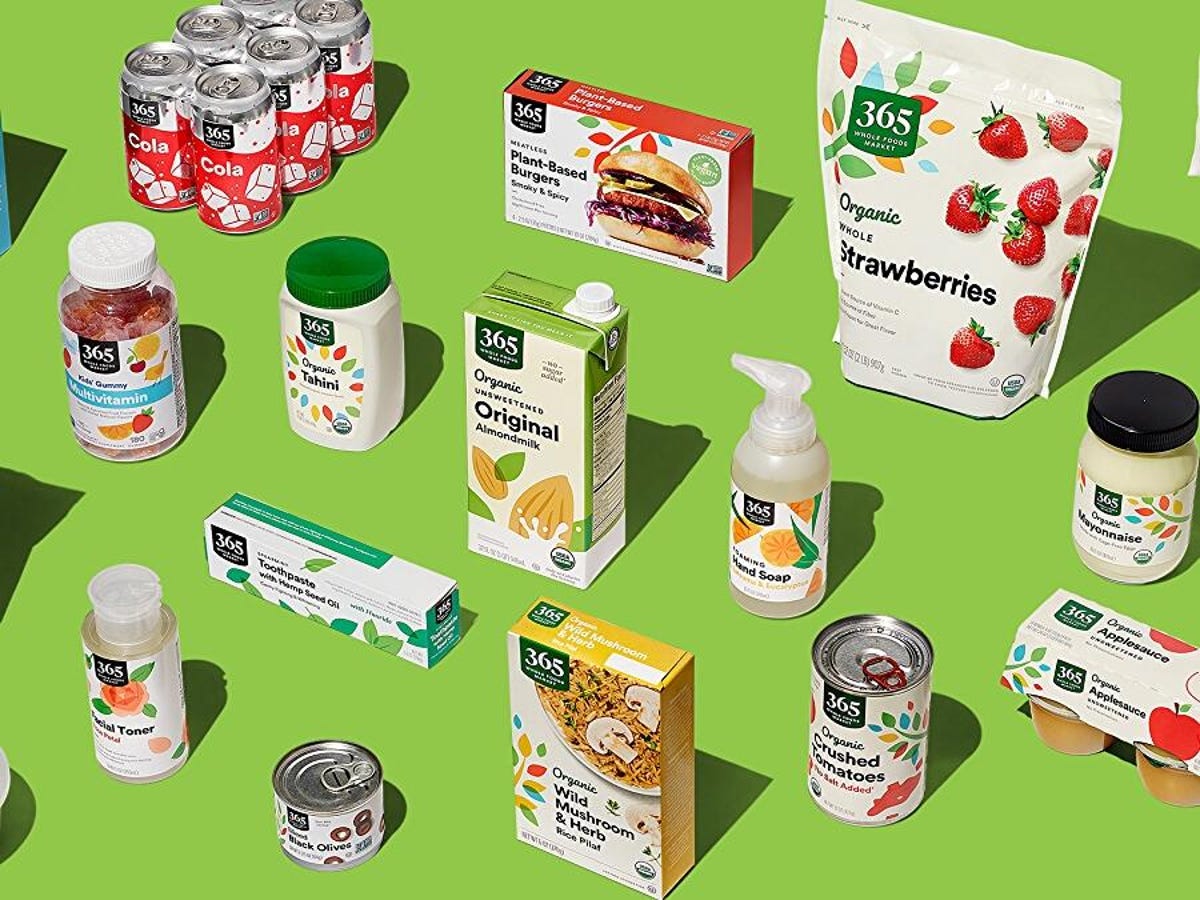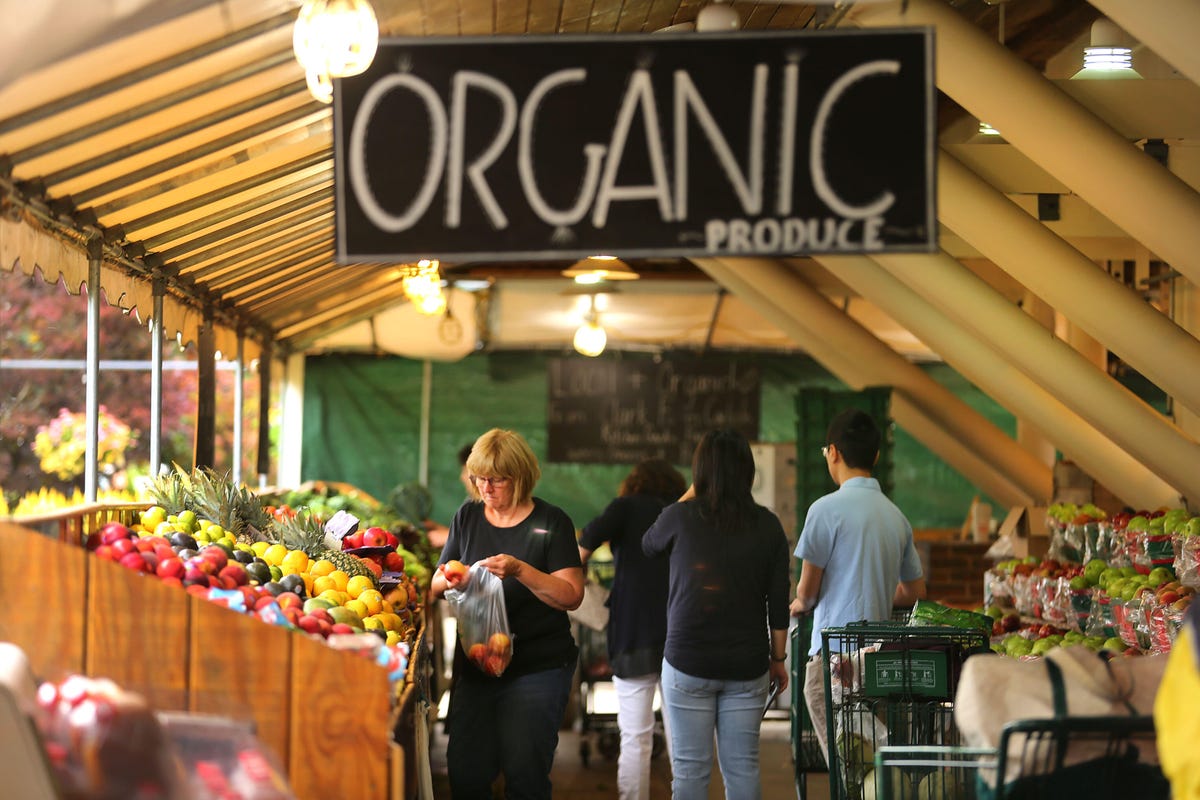We’ve all been there; holding a bag of organic carrots in one hand and a bag of non-organic in the other, mulling over the pros and cons and deciding if it’s really worth the extra dough. There are certainly benefits to eating organic produce, meats and other foods (more on that in a bit), but an organic lifestyle also comes at a cost. If you’ve ever wondered exactly how much more it’ll cost you to buy organic groceries versus non-organic, I’ve done the math.
To find the difference, I ran a typical grocery list through the ole’ calculator for both organic and non-organic options at two online grocery retailers — FreshDirect and Amazon Fresh — to see how big the price difference actually is. For some foods, the price hike for organic was substantial, but for others, choosing organic wasn’t as big a jump in cost as you might think. And sometimes, there was no difference at all. Overall, the final figures surprised me, and it turns out you can get many organic groceries online for around the same cost as non-organic — or just slightly more.
We previously did the math to see how much you can save buying store-brand groceries, if shopping for groceries online is cheaper than in-store and if buying meal kits saves you money over buying groceries. Here we break down how much more organic groceries cost than non-organic.
FreshDirect: Organic vs. non-organic
| FreshDirect non-organic | FreshDirect organic | |
|---|---|---|
| Eggs/dairy: | ||
| Brown eggs (12) | $3.49 | $4.89 |
| Milk (1/2 gallon) | $4.59 | $4.79 |
| Quart of plain yogurt (32 oz) | $6.29 | $5.49 |
| Subtotal | $14.37 | $15.17 |
| Produce: | ||
| Yukon gold potatoes (1 lb) | $1.49 | $2.39 |
| Mixed salad greens (5 oz) | $5 | $4 |
| Hass avocado (1) | $2 | $2 |
| Carrots (1 lb) | $1.49 | $1.49 |
| Yellow onions (1 lb) | $1.25 | $1.59 |
| Gala apples (1 lb) | $2 | $2.33 |
| Strawberries (16 oz) | $7 | $11 |
| Bananas (2-3 lbs) | $2 | $3 |
| Lemon (1) | $1 | $1.49 |
| Subtotal | $23.25 | $29.29 |
| Pantry: | ||
| Bottle of Ketchup (32 oz) | $3 | $2.99 |
| White rice (1 lb) | $1.70 | $4.00 |
| Chicken stock (32 oz) | $2.99 | $4.99 |
| Ground coffee (10 oz) | $10.79 | $8.29 |
| Penne pasta (16 oz) | $2.39 | $2.99 |
| Pasta sauce (24 oz) | $2.79 | $4 |
| Subtotal | $23.66 | $27.26 |
| Bread and snacks: | ||
| Toasted O’s cereal (8 oz) | $3.02 | $3.19 |
| Corn chips (8 oz) | $3 | $2.66 |
| Granola bars (box of 6) | $4.29 | $5.90 |
| Apple Juice (64 oz) | $4.29 | $3.39 |
| Loaf of whole grain bread | $5 | $5.79 |
| Subtotal | $19.60 | $20.93 |
| Meat/fish: | ||
| Ground beef (1 lb) | $6 | $10.00 |
| Skinless chicken thighs (1 lb) | $5.29 | $8.29 |
| Whole chicken (3 lb) | $7.50 | $14.07 |
| Chicken breast (1 lb) | $6.29 | $9.00 |
| Ground turkey (1 lb) | $5.89 | $8.00 |
| Subtotal | $30.97 | $49.36 |
| Total | $111.85 | $142.01 |
How I did the math
To get a more holistic view of organic costs, I looked at the prices for organic and non-organic at both FreshDirect and Amazon Fresh — two popular online grocery services. I chose a selection of fruits, vegetables, meats, dairy products and snacks. For calculating the costs, I chose the cheapest option for both organic and non-organic. In cases where the product size was unequal, I used a per-pound or per-ounce cost to ensure the comparison was as even as possible.
Some items, particularly at Amazon Fresh, were not available organic, so I omitted them. This is why you’ll notice the totals for FreshDirect are higher than those for Amazon Fresh.
Amazon Fresh: Organic vs. non-organic
| Amazon Fresh non-organic | Amazon Fresh Organic | |
|---|---|---|
| Eggs/dairy: | ||
| Brown eggs (12) | $4.79 | $4.79 |
| Milk (1/2 gallon) | $4.39 | $4.19 |
| Quart of plain yogurt (32 oz) | $4 | $5 |
| Subtotal | $13.18 | $13.98 |
| Produce: | ||
| Yukon gold potatoes (1 lb) | $1.20 | $3.33 |
| Mixed salad greens (5 oz) | $1.69 | $3.19 |
| Hass avocado (1) | $2.29 | $1.75 |
| Carrots (1 lb) | $1.25 | $1.49 |
| Yellow onions (1 lb) | $1.19 | $1.49 |
| Gala apples (1 lb) | $3 | $1.93 |
| Strawberries (16 oz) | N/A | N/A |
| Bananas (2-3 lbs) | $1.73 | $1.89 |
| Lemon (1) | $1 | $1 |
| Subtotal | $13.35 | $16.07 |
| Pantry: | ||
| Bottle of Ketchup (32 oz) | $5.69 | $4 |
| White rice (1 lb) | $1.89 | $2.88 |
| Chicken stock (32 oz) | $1.89 | $2.49 |
| Ground coffee (10 oz) | $5.29 | $6.23 |
| Penne pasta (16 oz) | $1.19 | $1.69 |
| Pasta sauce (24 oz) | $3.59 | $2.69 |
| Subtotal | $19.54 | $19.98 |
| Bread and snacks: | ||
| Toasted O’s cereal (8 oz) | N/A | N/A |
| Corn chips (8 oz) | $2.49 | $2.99 |
| Granola bars (box of 6) | $3.79 | $2.59 |
| Apple Juice (64 oz) | $3.39 | $3.69 |
| Loaf of whole grain bread | $4 | $6.49 |
| Subtotal | $13.67 | $15.76 |
| Meat/fish: | ||
| Ground beef (1 lb) | $4.69 | $8 |
| Skinless chicken thighs (1 lb) | $5.11 | $8 |
| Whole chicken (3 lb) | N/A | N/A |
| Chicken breast (1 lb) | $5 | $13.49 |
| Ground turkey (1 lb) | N/A | N/A |
| Subtotal | $14.80 | $29.49 |
| Total | $74.54 | $95.28 |
How much more expensive is organic than non-organic?
Shopping at FreshDirect, it’s about 22% more expensive to buy organic than non-organic, but most of that difference comes from buying meat. If you were to remove meat from the equation, it would only be about 13% more expensive to choose organic foods. In fact, certain food categories, including bread and snacks and dairy and eggs, were nearly even in price.
Amazon Fresh shoppers can expect to pay about 21% more for choosing all organic groceries. Yet again, the biggest delta comes from the meat category. If you were to remove meat from the list, the difference would be about 8% to choose organic over non-organic.
Read more: Chicken Labels Are Confusing. Here’s What They Do (and Don’t) Mean
What are the most expensive organic foods?
The biggest jump in price for organic foods was for meat — by far. Some organic meats such as chicken breast were more than double the price when you picked organic over non-organic. There was also a fairly significant cost bump for some organic pantry items versus non-organic, particularly at FreshDirect.

Meats at both FreshDirect and Amazon Fresh jump significantly in price when you choose organic.
Screenshot by David Watsky/CNET
What are the least expensive organic foods?
At these two online grocery retailers, several categories were extremely close in price, although organic usually outpaced non-organic by at least a few coins. Pantry items, eggs and dairy, and even produce were surprisingly similar in cost. Some items, including the jarred pasta sauce were cheaper than non-organic when you chose the least expensive organic option. Salad greens were also nearly dead even for both types. The latter is very good news since that’s a category of food you don’t definitely want doused in pesticides.

Many of Amazon Fresh’s organic store-brand groceries were surprisingly similar in price to their non-organic counterpart.
Whole Foods
What exactly is organic food?
There is an ongoing discussion about the benefits of eating organic and the standards and regulations are often changing. That said, the USDA defines certified organic foods as ones that “are grown and processed according to federal guidelines addressing, among many factors, soil quality, animal raising practices, pest and weed control and use of additives. Organic producers rely on natural substances and physical, mechanical or biologically based farming methods to the fullest extent possible.”
Standards for growing organic produce, in the US as of 2020, include a set of cultural, biological and mechanical practices that support the cycling of on-farm resources, promoting ecological balance and conserving biodiversity. Studies have found that there are higher antioxidant levels in organically grown foods. There’s also evidence that organic food has lower toxic, heavy metal levels and less pesticide residue, with organic eggs, meat and dairy products containing more good-for-you omega-3 fatty acids.

Certain foods including leafy greens and produce with soft skin are more likely to absorb chemicals and, thus, buying organic may be the right move.
Getty Images
For some foods, it’s better to buy organic than for others
While you can find the organic version of just about any type of food, some may be worth the extra money more than others. Foods with thick skin that isn’t eaten are often less vulnerable to chemicals and pesticides; nuts and bananas are just two examples. Other foods with edible skin (or no skin) such as berries, salad greens and apples are more likely to be affected by pesticides and other agricultural chemicals.
More money-saving kitchen intel
Buying Organic Groceries: How Much More Does It Actually Cost? We Do the Math – CNET
Source: Media Star Philippines


0 Comments